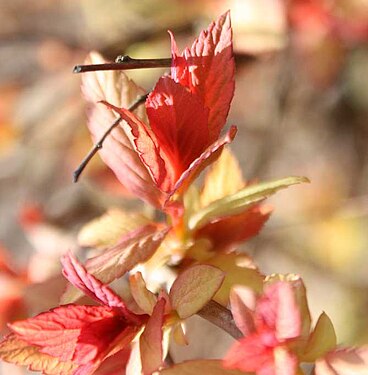Spiraea japonica
| Habit | shrub
| |
|---|---|---|
| Height: | ⇕ | 6 ft"ft" can not be assigned to a declared number type with value 6. |
| Width: | ⇔ | 4 ft"ft" can not be assigned to a declared number type with value 4. |
| Lifespan: | ⌛ | perennial |
| Bloom: | ❀ | early summer, mid summer, late summer |
| Exposure: | ☼ | sun |
|---|---|---|
| Water: | ◍ | moist, less when dormant |
| Features: | ✓ | deciduous, flowers, naturalizes, invasive |
| USDA Zones: | 3 to 10 | |
| Flower features: | ❀ | red, pink, white |
|
Rosaceae > |
Spiraea > |
japonica > |
Spiraea japonica (Japanese spiraea) is a plant in the family Rosaceae.[1] Synonyms for the species name are Spiraea bumalda Burv. and Spiraea japonica var. alpina Maxim.[2]
Spiraea japonica is one of several Spiraea shrubs with alternate, simple leaves, on wiry, freely branching, erect stems. Stems are brown to reddish-brown, round in cross-section and sometimes hairy. The shrub reaches 1.2 m to almost 2 m in height and about the same in width. The deciduous leaves are generally an ovate shape about 2.5 cm to 7.5 cm long, have toothed margins, and alternate along the stem. Clusters of rosy-pink flowers are found at the tips of the branches. The seeds measure about 2.5 mm in length and are found in small lustrous capsules.[2]
It is naturally variable in form and there are many varieties of it in the horticulture trade. So far, nine varieties have been described within the species.[2]
Spiraea japonica is a deciduous, perennial shrub native to Japan, China, and Korea. Southwest China is the center for biodiversity of the species.[2] It is naturalized throughout much of the Northeast, Southeast, and Midwest areas of the United States, and parts of Canada.[3]
A common habitat for S. japonica in general seems to be in riparian areas, bogs, or other wetland habitats. It is found growing along streams, rivers, forest edges, roadsides, successional fields, and power line right-of-ways. It prefers full sun, but can tolerate partial shade. It prefers lots of water during the growing season; however, it cannot tolerate saturated soils for extended periods of time. It prefers a rich, moist loam, but it can grow in a wide variety of soils, including those on the alkaline side.[2]
Spiraea japonica was introduced in North America as an ornamental landscape plant and first cultivated in the northeastern states around 1870.[3]
It is a common ornamental. The tall forms are grown as hedges, low screens, or foundation shrubs. The low-growing forms are used as groundcovers or in borders. It has been used as traditional medicine by native people, and extracts from the plants were found to be bioactive.[2]
Spiraea japonica have become naturalized and occupy habitats similar to those of native spireas. It aggressively invades disturbed areas and forms dense stands that outcompete native species. It often spreads locally when its hardy seeds are transported along watercourses and in fill dirt.[2]
Once established, S. japonica grows quickly and forms dense stands that outcompete much of the existing native herbs and shrubs. The seeds can last for many years in the soil, making its control and the restoration of native vegetation especially difficult. Growing populations will creep into meadows, forest openings, and other sites.[2]
Read about Spiraea japonica in the Standard Cyclopedia of Horticulture
|
|---|
|
Spiraea japonica, Linn. (S. callosa, Thunb.). Shrub, 4 ft. high, with upright branches glabrous or puberulous when young: lvs. ovate to oblong-lanceolate, acute at both ends or acuminate, doubly and incisely serrate, pale bluish green and usually glabrous beneath, 1-4 in. long: fls. small, pale to deep pink, in usually much-compound and rather loose corymbs; sepals reflexed in fr.: follicles glabrous, diverging with ascending styles. June, July. Japan, China.—A very variable species. The variety most common in cult. usually under the name S. callosa is var. Fortunei, Rehd. (S. Fortunei, Planch. S. callosa, Lindl., not Thunb.). Higher, with quite terete branches: lvs. 2-4 in. long, oblong-lanceolate, acuminate, sharply and doubly serrate, with incurved, callous-tipped teeth, rugose above, bluish white beneath: corymbs very compound, rather loose; disk less developed, sometimes wanting. E. and Cent. China. F.S. 9:871. B.M. 5164. B.H. 8:129.—Handsome shrub with the young unfolding lvs. of a pretty purplish color and very large much-compound corymbs. The Japanese forms grow less high, have smaller and broader, coarsely doubly dentate-serrate lvs., not rugose and less whitish beneath; the sts. are slightly striped by the decurrent petioles and the infl. is less compound. Other varieties of Chinese origin are the two following recently intro. varieties. Var. acuminata, Franch. Lvs. ovate-oblong to lanceolate, acuminate, green and pubescent beneath, at least on the veins, 2-3 1/2 in. long: fls. pink, in terminal corymbs 4-6 in. across. Cent. and W. China. Var. ovalifolia, Franch. Lvs. oval to elliptic, acute, glabrous and glaucescent beneath, 1 1/2 - 3 in. long: fls. white, in corymbs 3-5 in. across. W. China.—Japanese forms little known in cult. are var. pubescens, Regel, with the lvs. pubescent beneath and the corymbs pubescent, and var. glabrata, Nichols. (S. glabrata, Lange), with ovate glabrous lvs. and bright pink fls. in glabrous corymbs. The following are garden forms: Var. atrosanguinea, Zabel. Fls. deep pink, in tomentose corymbs. Var. ruberrima, Zabel. Fls. deep pink, in puberulous corymbs. Var. macrophylla, Simon-Louis. Lvs. becoming 6 in. long, bullate: corymbs small. Var. variegata, Hort. Lvs. variegated with yellowish white. Most of the other forms enumerated as varieties under this species are hybrids. CH
|
Cultivation
Propagation
Pests and diseases
Varieties
Gallery
References
External links
- w:Spiraea japonica. Some of the material on this page may be from Wikipedia, under the Creative Commons license.
- Spiraea japonica QR Code (Size 50, 100, 200, 500)






